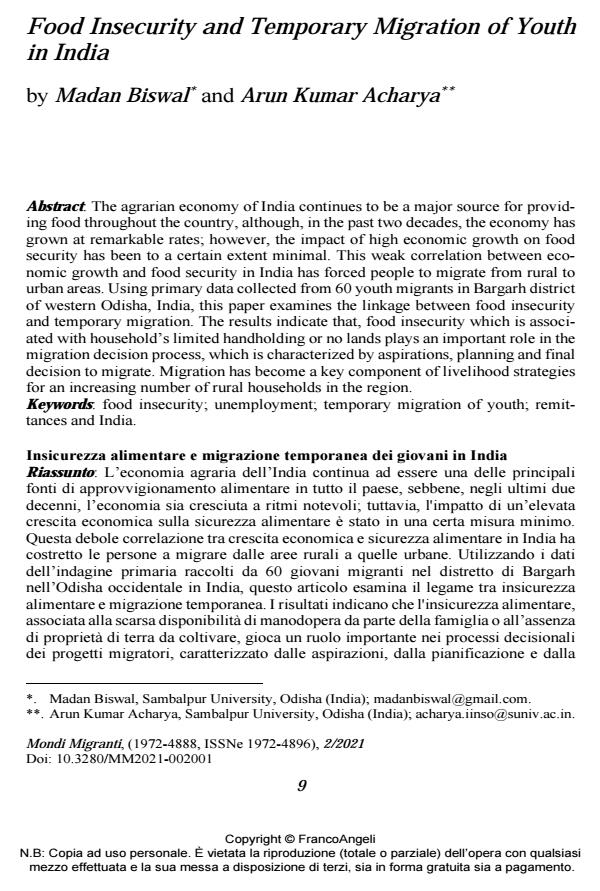Food Insecurity and Temporary Migration of Youth in India
Titolo Rivista MONDI MIGRANTI
Autori/Curatori Madan Biswal, Arun Kumar Acharya
Anno di pubblicazione 2021 Fascicolo 2021/2
Lingua Inglese Numero pagine 15 P. 9-23 Dimensione file 175 KB
DOI 10.3280/MM2021-002001
Il DOI è il codice a barre della proprietà intellettuale: per saperne di più
clicca qui
Qui sotto puoi vedere in anteprima la prima pagina di questo articolo.
Se questo articolo ti interessa, lo puoi acquistare (e scaricare in formato pdf) seguendo le facili indicazioni per acquistare il download credit. Acquista Download Credits per scaricare questo Articolo in formato PDF

FrancoAngeli è membro della Publishers International Linking Association, Inc (PILA)associazione indipendente e non profit per facilitare (attraverso i servizi tecnologici implementati da CrossRef.org) l’accesso degli studiosi ai contenuti digitali nelle pubblicazioni professionali e scientifiche
The agrarian economy of India continues to be a major source for providing food throughout the country, although, in the past two decades, the economy has grown at remarkable rates; however, the impact of high economic growth on food securi-ty has been to a certain extent minimal. This weak correlation between economic growth and food security in India has forced people to migrate from rural to urban areas. Using primary data collected from 60 youth migrants in Bargarh district of western Odisha, India, this paper examines the linkage between food insecurity and temporary migration. The results indicate that, food insecurity which is asso-ciated with household’s limited handholding or no lands plays an important role in the migration decision process, which is characterized by aspirations, planning and final decision to migrate. Migration has become a key component of livelihood strategies for an increasing number of rural households in the region.
L’economia agraria dell’India continua ad essere una delle principali fonti di ap-provvigionamento alimentare in tutto il paese, sebbene, negli ultimi due decenni, l’economia sia cresciuta a ritmi notevoli; tuttavia, l'impatto di un’elevata crescita economica sulla sicurezza alimentare è stato in una certa misura minimo. Questa debole correlazione tra crescita economica e sicurezza alimentare in India ha co-stretto le persone a migrare dalle aree rurali a quelle urbane. Utilizzando i dati dell’indagine primaria raccolti da 60 giovani migranti nel distretto di Bargarh nell’Odisha occidentale in India, questo articolo esamina il legame tra insicurezza alimentare e migrazione temporanea. I risultati indicano che l'insicurezza alimen-tare, associata alla scarsa disponibilità di manodopera da parte della famiglia o all’assenza di proprietà di terra da coltivare, gioca un ruolo importante nei processi decisionali dei progetti migratori, caratterizzato dalle aspirazioni, dalla pianifica-zione e dalla decisione finale di migrare. La migrazione è diventata una compo-nente chiave delle strategie di sostentamento per un numero crescente di famiglie rurali nella regione.
Parole chiave:insicurezza alimentare; disoccupazione; migrazione temporanea di giovani; rimesse e India.
Madan Biswal, Arun Kumar Acharya, Food Insecurity and Temporary Migration of Youth in India in "MONDI MIGRANTI" 2/2021, pp 9-23, DOI: 10.3280/MM2021-002001